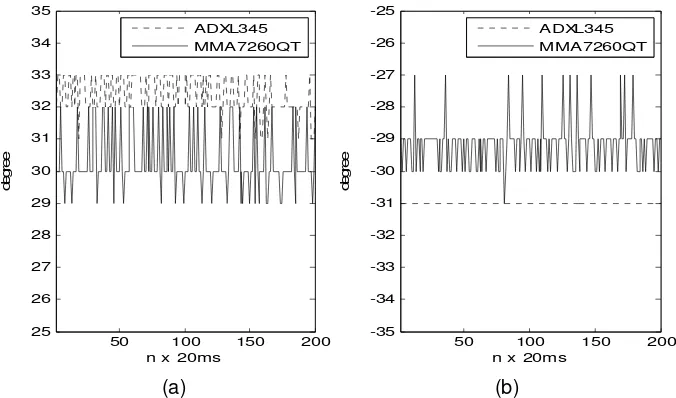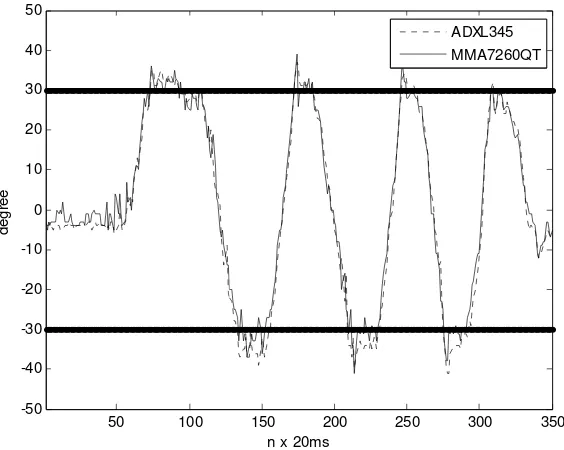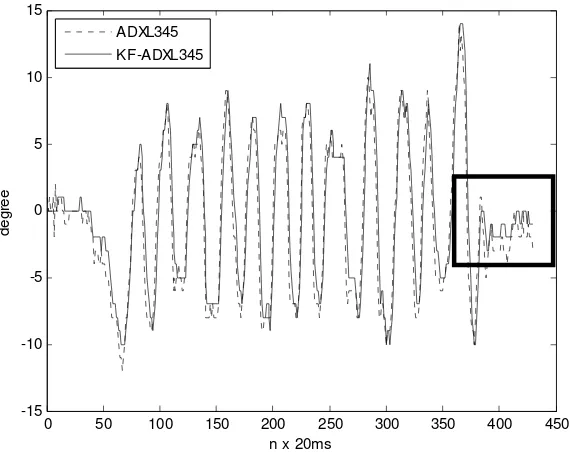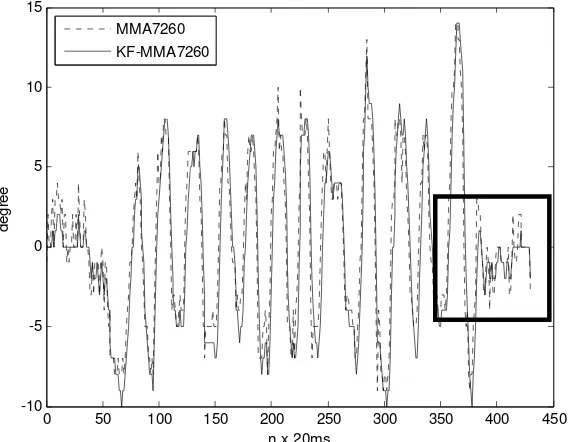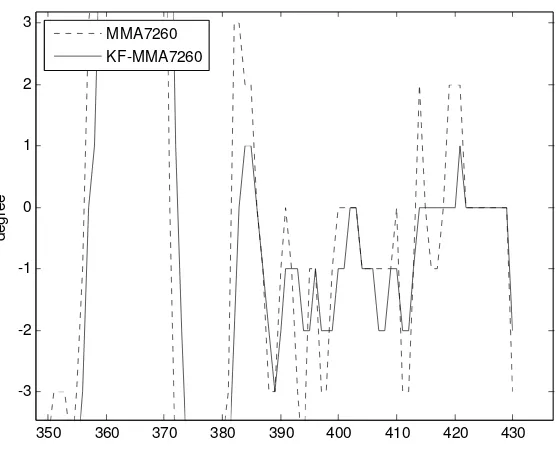accredited by DGHE (DIKTI), Decree No: 51/Dikti/Kep/2010 1
Performance Evaluation of MMA7260QT and ADXL345
on Self Balancing Robot
Hany Ferdinando1, Handry Khoswanto1, Djoko Purwanto2
1
Department of Electrical Engineering, Petra Christian University Siwalankerto 121-131 Surabaya, Phone: +62 31 2983446 Fax: +62 31 8436418
2
Department of Electrical Engineering, Sepuluh Nopember Institute of Technology Kampus ITS Keputih, Surabaya, Phone: +62 31 599 4251-54 Fax: +62 31 593 1237
e-mail: {hanyf,handry}@petra.ac.id, [email protected]
Abstrak
Pengendali self balancing robot (SBR) harus mampu mendeteksi kemiringan sebuah platform. Dalam hal ini, sistem menggunakan sensor untuk mendeteksi akselerasi. Dari berbagai macam jenis sensor ini, terdapat sensor dengan keluaran analog dan digital. Permasalahan yang diangkat dalam paper ini adalah bagaimana memilih sensor yang tepat untuk diaplikasikan pada SBR. ADXL345 mewakili sensor dengan keluaran digital dan MMA7260QT mewakili sensor dengan keluaran analog. Sistem menggunakan Arduino untuk membaca dan mengirim data ke komputer untuk dianalisis. Pengujian dilakukan berdasarkan tiga kriteria, yaitu kondisi stasioner, tanggapan dinamik dan kolaborasi dengan gyroscope melalui tapis Kalman. Kedua sensor dioperasikan pada sensitivitas terendah. Berdasarkan kriteria stasioner, ADXL345 unggul dibandingkan dengan MMA7260QT. Pada tanggapan dinamik, kedua sensor terganggu dengan noise yang muncul karena sistem mendeteksi akselerasi saat platform bergerak. Jadi, saat itu sensor tidak hanya membaca gravitasi tetapi juga akeselerasi platformnya. Dalam hal ini, tingkat derau ADXL345 masih lebih rendah dibandingkan dengan yang lain. Penggunaan tapis Kalman pada sistem menunjukkan bahwa kedua sensor dapat bekerja dengan baik. Jika hasil dari ketiga kriteria ini digabungkan dengan perangkaian sensor ke Arduino, maka penelitian ini merekomendasikan ADXL345. Selain itu, sensor ini juga memiliki beberapa fitur yang bermanfaat untuk menangani akeselerasi yang berubah tiba-tiba.
Kata kunci: accelerometer, Arduino, Kalman filter, gyroscope
Abstract
A self balancing robot (SBR) controller needs to detect platform inclination. For this purpose, an accelerometer is used. From various types of accelerometer, we can divide into digital and analog ones. The problem is how to select the right type for the SBR. This paper evaluates the performance of the ADXL345, 3-axis digital output accelerometer and the MMA7260QT, 3-axis analog output accelerometer. The Arduino is used to read data from the sensor and send it to PC for plotting. Both sensors use the lowest sensitivity. The sensors are evaluated with three criteria, i.e. stationary, dynamical response and collaborating with ITG3200 3-axis gyroscope for Kalman filter fusion. For stationary criterion, the ADXL345 is better than the other sensor for all stationary position. For dynamical response, both sensors suffer from the noise due to acceleration of the platform. The sensors do not only sense the gravity but also the acceleration of the platform when it is moved. But the noise level for the ADXL345 is lower than the other. Using Kalman filter makes both sensors show good performance for a SBR application. If three criteria are combined with hardware aspect, then the authors recommend using the ADXL345. Besides, it has several useful features to handle abrupt acceleration.
Keywords: accelerometer, Arduino, Kalman filter, gyroscope
1. Introduction
A self balancing robot (SBR) is two-wheel robot which can balance itself against disturbance. The SBR is very interesting plant due to its instability. The challenge is to control the SBR in order to balance itself in various conditions.
with microcontroller, noise and combination with gyroscope sensor. The gyroscope sensor is ITG3200 from InvenSense [2].
Some might think that accelerometer in the SBR is used to detect the acceleration of the robot. For, some reason, this idea is correct but the acceleration is not the point in the SBR.
Indeed, from its name, the accelerometer detects acceleration usually written in m/s2. This unit is the same as gravity. So this sensor must detect the gravity also. When the gravity is parallel to its axis, the sensor detects 1g along that axis. The sign is either positive or negative, it depends the direction of the axis. The other axes which are perpendicular to the gravity will give 0g. This is called the static acceleration.
Figure 1. Accelerometer orientation for each axis [3]
When the axes are neither parallel nor perpendicular, the static accelerometer is no longer 1g or 0g. The values depend on the inclination of the sensor. We can calculate the acceleration detected by each axis with trigonometric formula or the other way around.
Since the accelerometer signal is buried in noise, the inclination will be noisy too. For this reason, a gyroscope is placed to help the system calculate the inclination of a platform. Unfortunately, gyroscope suffers from drift. So, Kalman filter is used to combine signals from both sensors to produce inclination information [4]. As Kalman filter is also useful in estimation [5]. Here, the Kalman filter is used to estimate drift of the gyroscope.
2. Research Method
Both sensors are placed on the same board and experience the same acceleration by rotating the platform. The accelerometers are used to detect the inclination of the platform as it is used on the SBR project. Angle is measured from normal line of the platform. See figure 2 for detail.
(a) (b)
Figure 2. Normal line of the platform as reference position [6] (a) 0o and (b) 25o
In order to use the accelerometer to measure an inclination of a platform, it is important to derive a formula for this purpose. Figure 3 shows one axis of an accelerometer with inclination and degrees from the zero degree reference point (see figure 2).
Figure 3. Inclination of a platform and the accelerometer readings
The output of the accelerometer is AccY for its vector is parallel with 1g. So when the platform is in zero degree position, the output must be 0g. In analog accelerometer, the output is half of the power supply. For digital accelerometer, the output is half of the full scale reading.
When the platform starts to incline up or down, the AccY changes from 0g to either positive (figure 5a) or negative (figure 5b) values. As the inclination is increasing, the AccY might be either 1g or -1g. This condition means and is 90o. The relationship between Acc and AccY can be written as
With Acc equal to 1g and AccY value is converted to g, (1b) can be written as
A
arcsin
(1c)with A is a fraction of AccY (in term of g) divided by 1g, so A is unitless. Angle (and ) is the inclination angle of the platform. This is the interest angle of the SBR controller. Unfortunately, the angle signal is noisy due to the sensitivity of the accelerometer.
First, it is interesting to compare noise level from both sensors at stationary condition. It means the platform is still and one the axis ‘feel’ 1g and the other 0g. When there accelerometers experience stable acceleration, i.e. 1g downward, the output must be around certain value and there is no oscillation. The oscillation can be considered as noise. This experiment will be conducted for several inclinations.
Third, the accelerometers are working together with a gyroscope to measure inclination. Combination of accelerometer and gyroscope on the SBR project is very common. The fusion accelerometer and gyroscope uses either complementary filter [7] or Kalman filter [4], [8], [9]. The gyroscope for this research is ITG3200 from InvenSense.
The final goal of these experiments is to give a recommendation for accelerometer for SBR project. Some drawbacks of the implementation are explored also.
2.1. Hardware Implementation
Microcontroller used in this research is Arduino Uno SMD edition. The Arduino uses AVR microcontroller and it is an open source project so anyone can make his own Arduino board. Detail information about this wonderful project can be found at http://www.arduino.cc.
The ADXL345 and ITG3200 are connected to I2C bus of the Arduino. The SDA and SCL pins are A4 and A5 respectively. So the connection for these digital output sensors is very simple. Compare to the previous sensors, the MMA7260QT is little bit complicated. Pin g-Select1 and g-Select2 must be set to the lowest sensitivity, i.e. 200mV/g. Using the highest sensitivity, 800mV/g, is not recommended due to its noise [9].
2.2. Software Implementation
The initialization of the ADXL345 can be read from [10]. It is simply set the Power On register to measure mode. The sensitivity is set to the lowest, i.e. 3.9mg/LSB.
The MMA7260QT does not need an initialization because its operation is controlled from logic value of g-Selec1 and g-Select2. With both pins get 3.3 volt, the MMA7260Qt is set to the lowest sensitivity also, i.e. 16mg/LSB.
3. Results and Analysis 3.1. Still Platform Experiments
The first experiment is to compare the noise level for both accelerometer sensors when the platform is at zero degree. Figure 4 shows the angle measured by both sensors.
It is shown that the noise level of the ADXL345 is smaller than the MMA7260QT, even both sensors are configured at the lowest sensitivity. The standard deviations of these measurements are 0.389 and 1.674 degrees for the ADXL345 and the MMA7260QT respectively. These values mean that the ADXL345 has higher consistency compare to the MMA7260QT.
The average value for these measurements is -1.814 and -0.721 degrees for the ADXL345 and the MMA7260QT respectively. Although the former sensor is not accurate as the later, this gives no further problem. User can add such an offset to compensate this error.
Next, the platform is positioned such that the sensor feels 1g. This position of the platform is ninety degree. Figure 5 shows the angle measurement for ninety degree in both directions.
The standard deviations for the ADXL345 and the MMA7260QT for ninety degree measurement are 0.122 and 0.923 degree respectively. For minus ninety degree, the standard deviations are 0.528 and 0.882 degree for the ADXL345 and the MMA7260QT. From these values, we can see that the ADXL345 gives higher consistency for the output. In other words, it is more stable. The average measurement error reading can be handled with such an offset.
Figure 4. Angle measurement for 0 degree
(a) (b)
Figure 5. Angle measurement for (a) 90 and (b) -90 degree
(a) (b)
Figure 6. Angle measurement for 30 and -30 degree
(degree) (degree) (degree) (degree) (degree) ADXL345 Standard Dev. Average -90.55 -31.00 -1.81 32.39 92.02 0.528 0.000 0.389 0.590 0.122 MMA7260QT Average -83.66 -29.18 -0.72 30.32 88.45
Standard Dev. 0.882 0.719 1.674 0.934 0.923
3.2. Rotating Platform Experiments
The goal of this experiment is to evaluate the response of both sensors when the platform is moving as in the SBR and the accelerometer is used to measure the inclination. The platform does not move regularly as in real SBR. Figure 7 and 8 shows the angle measurement when the platform is moving.
The measurement shows that both sensors can get the angle position. It is around ±30o (figure 7) and ±15o (figure 8) with small deviation. Although the MMA7260QT is a little behind the ADXL345 for the stationary position, these experiments show that both sensors have good performance for dynamic response, except when there is sudden direction changing of the platform.
The deviation in the measurements is due to the movement of the platform. The accelerometers do not only measure the acceleration from the gravity to measure the inclination but also acceleration of the platform when it is moving. This gives such an angle deviations. For the SBR application, the deviation must be avoided since the controller balance the SBR based on the angle position.
For this reason, the SBR must add gyroscope sensor to measure the inclination of the platform. Combination of accelerometer and gyroscope to measure inclination is called IMU (Inertial Measurement Unit) and the best algorithm for the IMU application so far is the Kalman filter [9]. The Kalman filter is already optimized for the Arduino. This paper does not discuss the tuning parameter for the Kalman filter; [9] shows how to tune the parameters.
Figure 7. Angle measurement when the platform is moving ±30o
50 100 150 200 250 300 350 -50
-40 -30 -20 -10 0 10 20 30 40 50
n x 20ms
degr
ee
Figure 8. Angle measurement when the platform is moving ±15o
3.3. Kalman filter Experiments
The gyroscope for this experiment is the ITG3200 from InvenSense. It is 3-axis digital output gyroscope sensor with I2C interface. Connecting the ITG3200 to the Arduino is very simple because it shares the same I2C bus with the ADXL345.
Figure 9 shows the data fusion of accelerometer and gyroscope for the ADXL345 and the ITG3200. The Kalman filter can estimate the angle correctly and suppress the noise. This is very helpful for the controller in order not to handle noisy angle measurement.
Figure 9. Kalman filter operation for the ADXL345 with the ITG3200
50 100 150 200 250 300 350 -25
-20 -15 -10 -5 0 5 10 15 20 25
deg
re
e
n x 20ms
ADXL345 MMA7260QT
0 50 100 150 200 250 300 350 400 450 -15
-10 -5 0 5 10 15
n x 20ms
d
egr
e
e
Figure 10. Zoom of square block in figure 9
The Kalman filter performance for the MMA7260QT and the ITG3200 combination works well, see Figure 11. Noisy signal from the MMA7260QT can be handled smoothly and the Kalman filter can estimate the angle position of the platform.
Figure 12 zooms the last part of the measurement in Figure 11. The Kalman filter successfully smooths the angle measurement from the MMA7260QT.
Figure 11. Kalman filter operation for the MMA7260 with the ITG3200
370 380 390 400 410 420 430 -4
-3 -2 -1 0
n x 20ms
degree
0 50 100 150 200 250 300 350 400 450 -10
-5 0 5 10 15
n x 20ms
deg
re
e
Figure 12. Zoom of square block in figure 11
Figure 13 shows the results of Kalman filtering for both sensors. The results are almost the same. This means both sensors work fine with the Kalman filtering process.
Figure 13. Kalman filter result of the ADXL345 and the MMA7260QT
4. Conclusion
From the stationary point of view, the ADXL345 shows better response than the MMA7260QT based on its consistency values. This consistency value is important to guarantee the output of sensors is stable enough when the platform is still. Both sensors have such an
350 360 370 380 390 400 410 420 430 -3
-2 -1 0 1 2 3
d
egr
ee
MMA7260 KF-MMA7260
0 50 100 150 200 250 300 350 400 450 -10
-5 0 5 10 15
n x 20ms
de
gre
e
important to handle the noise.
Noise from the dynamical response must be suppressed. A gyroscope is used and the Kalman filter algorithm combines data from the gyroscope and accelerometer into single data, i.e. angle. The implementation of the Kalman filter on both accelerometers shows good result. Noise can be suppressed well.
From hardware point of view, connecting the ADXL345 is easier than the MMA7260QT. The former only uses four cables but the later uses at least six cables (because it is operated the lowest sensitivity).
From software point of view, writing the code for the ADXL345 is more difficult because it uses either I2C or SPI interface. Fortunately, this project uses Arduino board with embedded library in it. One of the libraries supports the I2C operation. This makes the coding simpler. The MMA7260QT only uses ADC and it only need ADC initialization process.
From several points in this research, the authors recommend to use ADXL345 for the SBR application because the noise is small and it is easy to connect the sensor to the controller. Besides, the ADXL345 has several useful features to handle abrupt acceleration. This is very common in the SBR application.
Acknowledgement
This research is supported by Directorate General of Higher Education (DGHE) of Indonesia through Penelitian Hibah Bersaing (PHB) with contract number 526/E5.2/PL/2011.
References
[1] DR Santoso. A Simple Instrumentation System for Large Structure Vibration Monitoring.
TELKOMNIKA. 2010; 8(3): 265-274.
[2] SparkFun Electronics. IMU Digital Combo Board - 6 Degrees of Freedom ITG3200/ADXL345. 2010. Available: http://www.sparkfun.com/products/10121. [Accessed on May 5, 2012].
[3] FreeScale. 2004. Available: http://www.freescale.com/webapp/sps/site/prod_summary.jsp?
code=MMA7260QT. [Accessed on November 12, 2011].
[4] Starlino. Arduino Code for IMU Guide Algorithm. 2010. Available:
http://www.starlino.com/imu_kalman_arduino.html. [Accessed on November 12, 2011].
[5] W Budiharto, A Santoso, D Purwanto dan A Jazidie. Multiple Moving Obstacles Avoidance of Service
Robot using Stereo Vision. TELKOMNIKA. 2011; 9(3): 433-444.
[6] JD Warren, J Adams and H Molle. Arduino Robotics. New York: Apress. 2011.
[7] S Colton. The Balance Filter: a Simple Solution for Integrating Accelerometer and Gyroscope
Measurements for a Balancing Platform.2007.
[8] HD Dai, SW Dai, YC Cong and GB Wu. Performance Comparison of EKF/UKF/CKF for the Tracking of Ballistic Target. TELKOMNIKA. 2012; 10(7): 1537-1542.
[9] H Ferdinando, H Khoswanto and D Purwanto. Embedded Kalman filter for Inertial Measurement Unit
(IMU) on the Atmega8535. International Symposium on Innovation in Intelligent Systems and
Application (INISTA). Trabzon. 2012.
![Figure 1. Accelerometer orientation for each axis [3]](https://thumb-ap.123doks.com/thumbv2/123dok/252200.504499/2.595.120.482.305.492/figure-accelerometer-orientation-for-each-axis.webp)
![Figure 2. Normal line of the platform as reference position [6] (a) 0 o and (b) 25o](https://thumb-ap.123doks.com/thumbv2/123dok/252200.504499/3.595.120.474.292.386/figure-normal-line-platform-reference-position-o-b.webp)
